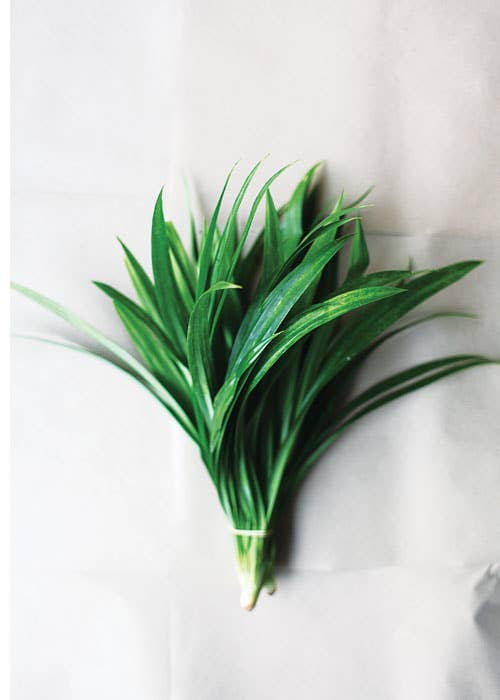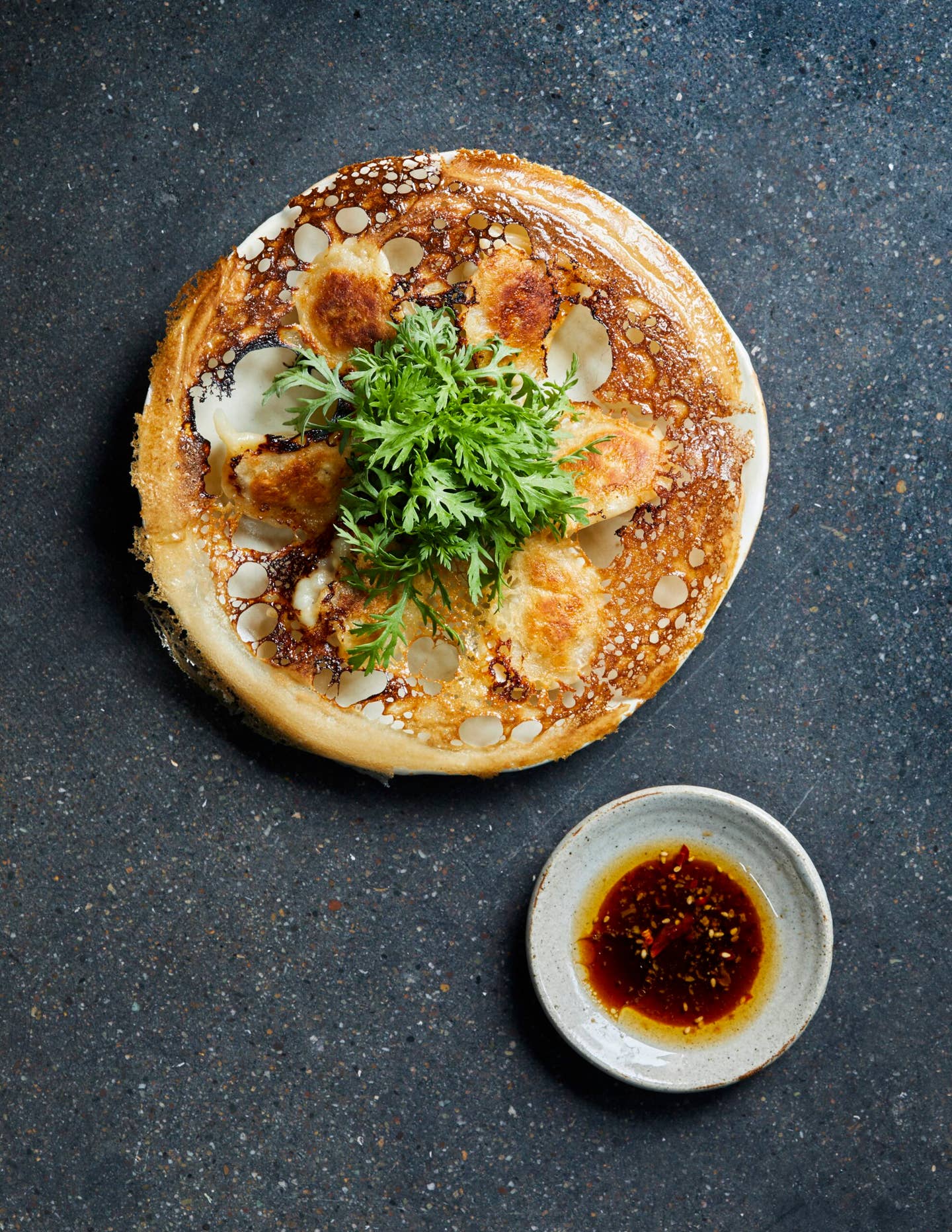
Blades of Glory
The Southeast Asian grass called pandan brings floral vivacity to all sorts of dishes
When I was growing up in Singapore, pandan—a perennial grass with an intoxicating aroma—was everywhere. Its subtle perfume suffused so many of my favorite foods: birthday cakes, the cassava cookies my grandma and I made for Chinese New Year, and the chicken simmered in a vibrant tomato and chile sauce that I got hooked on back in my teens. Still, I didn't realize how much I cherished it until I moved to London for college. That's when, living on my own for the first time, I discovered that cooking with pandan would instantly assuage any feeling of homesickness; my heart would lighten as my kitchen filled with its familiar smell of flowers, grass, popcorn, and hay. Even today in Singapore, simply walking past a pandan plant on a sweltering summer day and breathing in its sun-triggered scent is the shortest road to bliss I know.
The Pandanaceae family is a large one, its members ranging from small shrubs to huge trees. But the aromatic_ Pandanus amaryllifolius_, native to Southeast Asia, is the only species whose leaves are used for cooking. Called pandan wangi, fragrant pandan, in Indonesia, the plant is essentially a giant clump of grass, with long sharp blades spiraling outward from a central stem (hence its other common name, screwpine). Because of their length—anywhere from two to seven feet—the blades are generally cut into segments or tied into knots to get them to a manageable size. They are also tough and fibrous to the point of being inedible, so they are used as a seasoning only.
Cooks throughout Southeast Asia have devised a panoply of techniques for harnessing pandan's full character. The leaves can be spread out as a bed for steamed items, cut and folded to make cups for small confections, or blanched and then wrapped and tied around various fillings to make boiled dumplings. In Mangalore in southwestern India, large pandan leaves are coiled into cylindrical molds, filled with a fermented rice and lentil dough, and steamed to make fluffy breads called moode, which bear the impression of the leaf fibers as well as their heady aroma. Thai cooks infuse egg custard batter with pandan's flavor by tying a few leaves into a tight knot, then submerging them in the mixture and repeatedly massaging the bundles by hand, bruising them until they release their oils.
Gai Hor Bai Toey (Thai Pandan-Wrapped Chicken)
Pandan, the aromatic leaves of a perennial grass, are wrapped around chunks of coconut-milk-marinated chicken, steamed, and finally deep-fried in this sweet-savory Thai recipe. Steaming the chicken in pandan leaves imparts a floral fragrance, while deep-frying caramelizes the sugary marinade and browns the leaves, imbuing the meat with a nutty flavor. See the recipe for Gai Hor Bai Toey (Thai Pandan-Wrapped Chicken) »
As this range of preparations suggests, pandan is wonderfully adaptable; its flavor works equally well in both savory and sweet preparations. When using it for desserts, I'll pound the leaves to a pulp with a little water in a mortar and then wring out the viridian juice for two of my favorite Malay sweets. One of them is onde-onde, poached pandan-green rice flour dumplings with a shaggy coat of shredded coconut. Plump with a filling of melted palm sugar, they burst with a flowery sweetness when bitten.
The other is a beloved party treat from my boyhood: pandan chiffon cake. Tall and regal, it is a curious manifestation of America's culinary influence on my native country. In 1948, the U.S. magazine_ Better Homes and Gardens_ published a General Mills recipe for chiffon cake. Years later it made its way to Southeast Asia—most likely on boxes of imported cake flour—where it picked up a local flavor. By the 1970s, emerald green chiffon cake was all the rage from Indonesia to Singapore; it's just as popular today as it was 30 years ago. Most commercial versions of the cake are made with artificial pandan paste, a lurid Day-Glo green substance that bears as much resemblance to the real thing as cheap vanilla extract does to real vanilla bean. Shrill and cloying, it lacks the nuances of the fresh leaves. So when I bake pandan chiffon at home, I juice as many as 50 leaves to get a cake that, unlike the commercial versions, is naturally fragrant. It's one of my signature potluck dishes.
I also love using pandan to make the spicy, ruddy Malaysian dish ayam masak merah, chicken cooked in a tomato and chile gravy. I bruise a dozen leaves, then bundle and knot them before setting them to simmer in the sauce, where each bundle releases its oils. I always add extra leaves to the pot; their cool, sweet perfume tames the chiles' heat and softens the tomatoes' acidity. And a few leaves cut into three-inch pieces and added to a pot of plain rice imbue the grains with an exquisite flavor as it steams.
Pandan Chiffon Cake
Emerald green, fluffy pandan chiffon cake, beloved from Indonesia to Singapore, is a curious manifestation of America’s culinary influence on Southeast Asia. In 1948 Better Homes and Gardens published a General Mills recipe for chiffon cake. Years later the recipe made its way to Southeast Asia—most likely on boxes of imported cake flour—where home cooks made a version flavored with the juice from pandan, an aromatic grass with a floral, vanilla-like flavor. By the 1970s, viridian chiffon cake was all the rage, and it’s just as popular today as it was 30 years ago. See the recipe for Pandan Chiffon Cake »
I've also found that wrapping foods with the leaves is one of the easiest ways to impart pandan's flavor. A Thai friend showed me how to make_ gai hor bai toey_ by bundling marinated chicken chunks in the plant's larger leaves, then steaming the parcels and deep-frying them. Each time I make it, I watch closely as the leaves start to brown in the hot oil, inhaling deeply as the sugary marinade caramelizes and pandan's flowery scent morphs into a woodsy nuttiness.
Though I've been cooking with it for decades, pandan still delivers surprises. On a recent afternoon, I was in my kitchen making_ kue bika ambon_, a rich, eggy Indonesian cake prepared with coconut milk that's boiled with pandan leaves, lemongrass stalks, and kaffir lime leaves. By some mysterious synergy, the combined aromas of the finished dish conjured an extraordinarily vivid scent reminiscent of damask roses. I'd wager that a Parisian perfumer couldn't create anything better.
Keep Reading
Continue to Next Story










